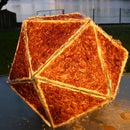Introduction: Cement Wallet
Do you spend too much money on wallets? Growing tired of how quickly they wear out? Find your salvation here, in a durable material well know since antiquity..
cement (pronounced like: sea-mint ).
1. A substance used to bind the stones or bricks of a building firmly together, to cover floors, to form walls, terraces, etc., which being applied in a soft and pasty state, afterwards hardens into a stony consistency; esp. a strong mortar, produced by the calcination of a natural or artificial mixture of calcareous and argillaceous matter.
2. gen.
a. Any substance applied in a soft or glutinous state to the surfaces of solid bodies to make them cohere firmly.
b. Any uniting medium or substance.
.
.
.
.
Step 1: Acquire Ingredients
Acquire the required ingredients. I found most of these to be quite affordable at home despot.
1. Cement : I used "SAKRETE" which is a cement that comes premixed with reinforcing fibres. Cement on its own is quite weak without some sort of reinforcing...hence all the gravel and rebar when you want to build something structural (like a highway overpass). The 50 pound bag will make enough "wallets" to last me a lifetime.
2. Reinforcing mesh : I used some mesh which is probably intended for stucco work. Again the same idea, you need some underlying armature to hold the cement together.
3. Metal shears or wire cutters to shape the mesh
4. A non-dairy whipped topping container to mix the cement in. You might be able to get away with an old dairy whipped topping container but it's risky
5. Liquid Cement Color : A fun way to create wallets in a variety of colors ranging from gray to gray-orange to pretty-damn-orange.
6. Household gloves; cement can be hard on your hands
Step 2: Assemble Ingredients
Cut wire mesh to form the "skeleton" or "armature" of your wallet. Do be careful, that stuff is sharp.
Ideally it is best to have a mold to contain the cement around the skeleton while it sets up. One possibility is to use your current wallet. Just pour cement around it to make a negative. Once that negative sets up, break it apart and grease it up for use as a form to make a positive. Keep in mind that this will almost certainly destroy your wallet, but remember that you will soon be replacing the old one with a far more durable cement wallet of similar dimensions.
We ended up shortcutting all this hassle by just using one of the rubber gloves as a form instead.
Mix concrete and concrete color with water in mixing tub. You want the cement to be wet thru and thru but not completely soupy. Pack the cement into your form around the armature. Work any air bubbles up to the surface by taping on the form.
Let cement set up overnight.
Step 3: Enjoy Your New Wallet
Once the cement has set up, you can remove it from the form. If you are using a one-time rubber form (such as a glove) it may be easiest to just cut it away from the cement.
Meet your new wallet. Since cement is such a durable material, it is best to remain on good terms as it will be holding your money for a long time to come. Once you get the hang of it, you can crank these out by the dozens. Varying the amount of concrete coloring gives a variety of final appearances. Clever manipulation of forms can yield a wide range of useful possibilities including drink holder, cigarette holder, toilet paper holder, toothbrush holder, etc.
In essence, anything you currently waste your time holding can now be easily and cheaply held by our new durable friend, concrete.













